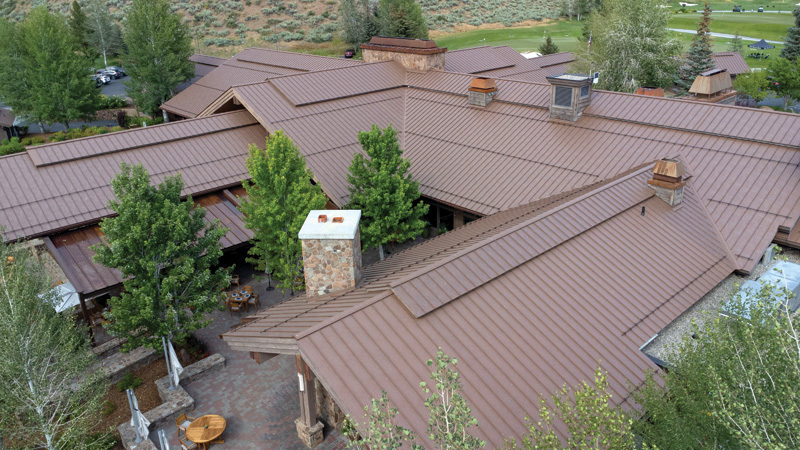
In areas where wildfires have become a perennial threat, ordinances have narrowed the options for roofing on new construction and reroofing projects. A specific example is Blaine County, Idaho, where installing a wood shake roof is no longer an option.
The Valley Club in Hailey, Idaho, is a 27-hole golf course that “promises a world-class golf experience for golf enthusiasts of all levels.” The main clubhouse required a Class A roof assembly to replace an aging wood shake roof with a different roofing material while maintaining a rustic aesthetic. The owners liked the look of a rusty standing seam roof but were interested in an alternative to actual A606 Weathering Steel.
Those seeking a rusty appearance on a metal roofing system have the option of PVDF-painted metal. The owners of The Valley Club chose a multi-coat finish, FX Iron Oxide, which allows for patterns of intricate detail and subtle depth for the 11,582 m2 (38,000 sf) project. Compared to other coated products, they preferred the aesthetics of the FX Iron Oxide, designed to mimic the look of rusted metal without the runoff of rusty moisture, which can create stains below. FX Iron Oxide is a PVDF coating offering protection against fade and chalking and carries a comprehensive non-prorated finish warranty.
Wildfires annually destroy thousands of structures, causing billions of dollars in damage. A Class A fire-rated roof can save a home or building. The National Fire Protection Association (NFPA) designates fire prevention classifications for roofing materials.
According to information on the Metal Roofing Alliance (MRA) website, metal roofing has a Class A rating because it can withstand flames for up to four hours and meet or exceed testing criteria as outlined by UL 790 (ASTM E 108) Standard Test Methods for Fire Tests of Roof Coverings.
The new roofing system is a 22-gauge Galvalume panel, 407 mm (16 in.) wide with a 38 mm (1.5 in) mechanically locked seam, offering a stronger and more wind-resistant system than a snap-lock panel of a through-fastened panel. This mechanically seamed system has a UL 90 rating for wind resistance.
Fire is not the only threat in Idaho, where winters bring plenty of snow. Hailey is the snowiest spot in Idaho, with a population of more than 5,000, averaging 2,253 mm (88.7 in.) inches of snow annually. Given this factor, the first order of business on the project was to have a crew from a local roofing company, Miley Roofing, shovel snow off the roof to speed up the start time. This amount of snow brings unique problems to a roofing system, which must be strong enough to hold significant weight. Secondly, what to do with the snow? Let it slide off on its own where it could cause injuries and property damage, or keep it on the roof with a snow retention system?
After completing the roofing installation, Miley Roofing installed 640 m (2,100 ft) of snow retention railings. For the Valley Club, as many as three rows of snow
rail were installed on some of the larger roof planes.
To prevent the formation of ice dams, what owner Troy Quesnel calls a Boston ridge vent, was installed. It is a continuous ridge vent that, when paired with continuous soffit venting, allows the roof to ventilate excess heat. This ridge vent system measures from 1.8 to 3 m (6 to 10 ft) for architectural scale, depending on the size of the roof plane.
Ice dams are a buildup of ice at the eave of a roof that prevents melted snow and ice from draining up the roof. When this melted snow and ice backs up, it can work its way under the roofing, getting into the home and damaging ceilings, walls, and insulation. Wet insulation loses R-value and creates a home for mold and mildew. If ice dams get large and heavy enough, they can also cause damage to gutters. Ice dams can be prevented by increasing the ventilation in the roofing system or adding insulation. Preventing any heat loss that will melt snow is an effective way to prevent ice dams from forming.
Some of the panels installed on The Valley Club are 15-m (50-ft) long, so Miley Roofing used floating clips that allow the metal to expand and contract freely, minimizing oil canning.
Wildfires and weather events should factor into roofing choices for new construction or reroofing projects to provide the best protection for customers. It also helps to be mindful of ordinances in each area, which may restrict roofing material options.
Peter Tuininga is the vice president of the Bryer Company.


